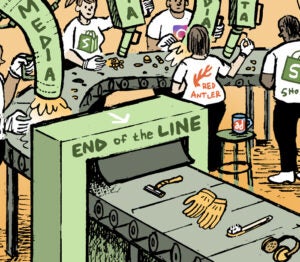 Mobile gaming company Gameloft removed all ad networks from its apps last year and hired a direct sales team.
Mobile gaming company Gameloft removed all ad networks from its apps last year and hired a direct sales team.
The company sees its future in advertising revenue, not from users making in-app purchases. And that means taking control of what will be its primary source of revenue.
Gameloft is one of the biggies in the mobile gaming world, with titles like “Siegefall” and “Spider-Man Unlimited.” It’s the top publisher in terms of app installs, with 700 million last year in more than 40 countries.
The problem with its freemium model is that the many are supported by the few.
“Ninety-seven percent of the audience wants to play great games but is not ready to invest in them,” said Sylvain Baudry, the senior director of advertising for the US. “The question as a publisher is how to keep producing the level of quality if 97% of the audience is not paying.”
That’s where advertising comes in.
Ad networks failed Gameloft in a number of ways. First, they didn’t drive revenue. Ad networks took a cut of the media spend and, without its own sales force, Gameloft couldn’t control how much of that spend went its way.
“Long term, we think it’s more risky to rely on third parties,” Baudry said.
Gameloft also couldn’t control the advertisers running through the network. That posed a problem for the games it created for licensors like the NFL, Marvel and Disney.
“In some games, you have brands that the licensor doesn’t want associated with the [intellectual property],” Baudry said. If we don’t manage campaigns ourselves, we don’t have control.”
And the company couldn’t make custom ad units or run sponsorships, nor could it control the timing of ads in a way that complemented the flow of a game.
AdExchanger Daily
Get our editors’ roundup delivered to your inbox every weekday.
Daily Roundup
To fix those problems, Gameloft couldn’t just hire a sales force to sell ads directly. It also needed to build technology – namely its own ad server.
This approach “gives us the flexibility to create ad units, execute according to what brands are interested in, and keep the control on what was happening in our games,” Baudry said. “We don’t want people to leave the game because they see an ad every 10 seconds.”
Building its own ad server allows Gameloft “to integrate easily into games, and modify if needed.”
Gameloft has assembled a wide range of ad units: classic mobile banners and “more complex solutions like in-game sponsorships, rich media campaigns and native and incentivized videos,” Baudry said.
Because Gameloft created its own technology for incentivized ads, it can be strategic about where to place the video ads. Ads are “integrated into the game economy,” Baudry said.
That means Gameloft can schedule ads so users watch videos only after key hurdles in each game. It can also make the experience fair in games with both paying, ad-free customers and users watching ads to unlock levels.
Those are things Gameloft couldn’t do using an outside company like Tapjoy, Baudry said.
“With these smart executions, we are seeing that our users are pretty responsive and receptive, not just pissed off by having advertising and more advertising,” he said.
That translates to better results for advertisers.
“Our benchmarks in terms of [click-through rate] and completions are higher than the average of the industry,” Baudry said.
To sell all these custom ad executions, Baudry leads a team of sales team of 10 in the US, and he’s still hiring. Gameloft has been calling on agencies since January.
Revenue this year will exceed what it brought in last year through networks, though the networks ran in just a few games, and not across Gameloft’s 30 titles.
Many of the direct buyers simply want to match the game context to their advertising. But Gameloft’s first-party data has greater applications, so it’s strengthening its data offerings to advertisers.
Gameloft is COPPA [Children’s Online Privacy Protection Act]-compliant, so it collects age ranges for all of its players. It’s working on adding gender and geolocation and bringing in third-party data. Plus, Gameloft conducts quarterly surveys of its audience.
Besides its first-party data, Gameloft has a couple other sources of data where it can glean information about users beyond its own apps. Apps can see the other apps installed on a device, so Gameloft is considering using this information to create a “travel” segment for people with travel apps, for example.
Data from users who sign in through Facebook Connect can’t be used for individual targeting, but “gives us a good vision game by game of the composition of the audience,” Baudry said.
Six months into its direct sales push, Gameloft has no immediate plans to add programmatic advertising to its mix. But that’s something it will likely re-evaluate “once we hit cruise level” with direct, he said. “We need more experience in the market to see what our fill rate will be.”
It plans on creating private marketplaces for buyers who want to use programmatic pipes, but will connect directly through its ad server, not work through an intermediary or SSP.
“We get more budget, and the agency gets direct access to premium inventory,” Baudry said. In general, he said he’s turned off by the huge value chain in programmatic, and hopes that some consolidation will occur before Gameloft dives back into programmatic.
In the meantime, Gameloft will have more competition on the direct side as mobile advertising matures. Baudry lists Zynga, Electronic Arts and Glu as other companies assembling their own teams to sell media directly to advertisers.













